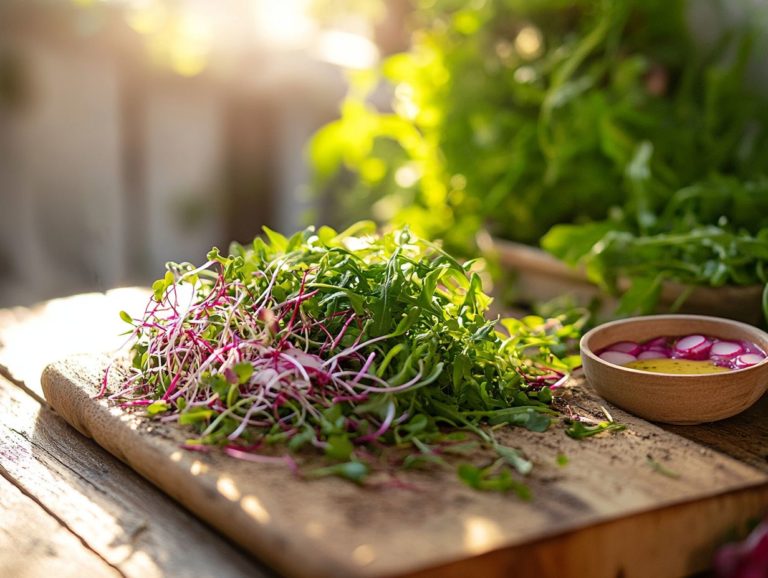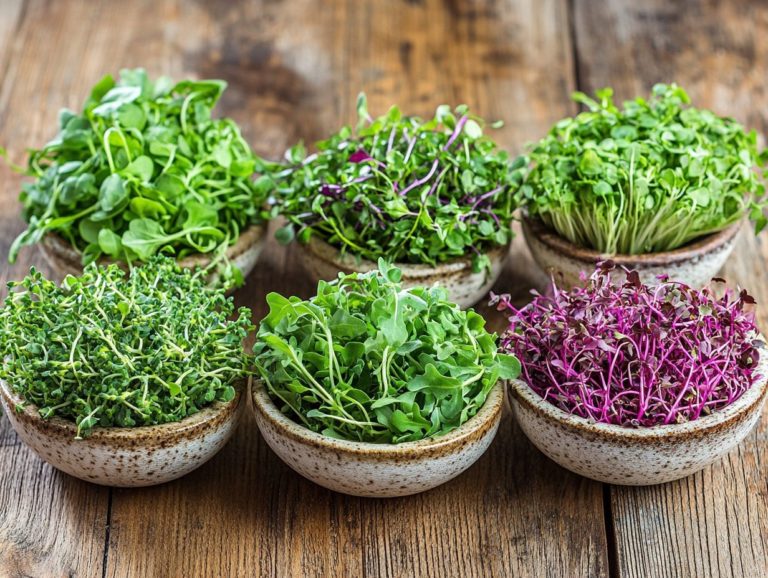Supercharge Your Meals with Microgreens
Microgreens are tiny, nutrient-dense plants that hold the potential to elevate your meals and enhance your well-being.
In this exploration, you ll uncover the remarkable nutritional advantages these vibrant greens offer and discover how simple it is to cultivate them right in your own kitchen.
You ll learn imaginative ways to weave microgreens into your dishes, identify the best varieties tailored to your culinary preferences, and become aware of any potential considerations.
Get ready to supercharge your meals with these incredible powerhouses!
Contents
Key Takeaways:

- Boost the nutritional value of your meals by adding microgreens, which are packed with vitamins, minerals, and antioxidants.
- Cultivate microgreens at home with minimal supplies and effort, and enjoy a constant supply of fresh, flavorful greens.
- Experiment with a variety of microgreens in your dishes to add color, texture, and a unique flavor to enhance the overall taste and presentation of your meals.
What are Microgreens?
Microgreens are the young edible plants that you ll want to harvest just after the first true leaves show up. Their popularity has surged, thanks to their vibrant colors, intense flavors, and impressive nutritional benefits, making them a go-to for anyone who cares about healthy eating.
Grown in special growing conditions, these miniature greens can encompass a variety of species, including Sunflower Microgreens, spinach, and many more. This variety allows you to create diverse and exciting dishes.
These tiny powerhouses not only pack a flavor punch but are also loaded with vitamins A, C, E, and K, not to mention essential minerals. The beauty of microgreens lies in their quick growth, often ready for harvest in just 7 to 21 days, putting fresh produce right at your fingertips. For health enthusiasts, exploring the top microgreen varieties can enhance your diet significantly.
You can elevate your breakfast game with microgreens, whether by adding a fresh, crunchy element to omelets or enhancing the visual appeal of salads with their vibrant hues. Discovering unique microgreens to elevate your dishes can take your meals to the next level. Many communities are also encouraging residents to grow plants in cities, sharing these nutrient-dense greens which fosters a sense of community and promotes healthier eating habits.
Nutritional Benefits
Microgreens are not just a feast for the eyes; they re also brimming with nutrients, often packing higher concentrations of vitamins, minerals, and antioxidants compared to their fully grown siblings. This makes them an incredibly potent addition to your healthy meals and vibrant salads.
Their exceptional nutritional profile delivers significant health benefits, making them a favorite among health enthusiasts and cooks alike. Loaded with essential nutrients like vitamins C, E, and K, along with minerals such as iron and calcium, these tiny greens can take your salads to the next level.
Research indicates that varieties like broccoli, radish, and pea shoots boast impressive antioxidant activity, potentially helping to reduce inflammation and strengthen your immune system.
By introducing microgreens into your diet, you can elevate your overall nutrient intake, particularly beneficial if you’re looking to fill dietary gaps. For anyone eager to enhance their meals, incorporating the best microgreens for nutritional value not only adds visual allure but also supports long-term health.
How to Grow Microgreens
Growing microgreens is an accessible and rewarding pursuit that demands minimal space and supplies, making it an ideal choice for everyone, whether you’re a novice gardener or a seasoned cultivator.
By adhering to a straightforward step-by-step process selecting the right seeds, preparing the soil, and ensuring ample light and moisture you can indulge in fresh ingredients that will elevate your culinary creations in a matter of days.
Why not give it a try? Start growing your own microgreens today and experience the incredible flavors and health benefits they bring to your meals!
Supplies and Step-by-Step Process

To successfully grow microgreens, you ll need a few essential supplies: containers, soil, seeds, and some cooking utensils for harvesting. Each of these components plays a vital role in the growing process. Understanding these requirements will ensure your microgreens thrive and provide you with the freshest ingredients for your meals.
Begin by selecting shallow trays or containers that offer excellent drainage with high-quality potting soil that retains moisture while allowing air to circulate around the roots. Opt for premium seeds known for their robust flavor and nutrients like radish, arugula, or basil.
Before planting, it s wise to soak the seeds for a few hours to boost germination. After planting, lightly cover the seeds with soil and mist gently to keep them in place. Regularly monitor moisture levels to ensure the soil remains slightly damp. Provide a suitable light source to foster healthy growth.
When your microgreens reach a height of about 2-3 inches, it s time to harvest. Use scissors to snip them just above the soil line making the experience straightforward and rewarding.
How to Use Microgreens in Your Meals
Incorporating microgreens into your meals can elevate flavors and provide a remarkable nutritional boost. They are an excellent choice for breakfast recipes, lunches, and gourmet salads.
Imagine topping your omelet with these vibrant greens or crafting a colorful salad that dazzles the palate. You could even explore innovative toast recipes that showcase their unique taste.
The possibilities for utilizing these nutritious greens in your meals are exciting and limitless!
Creative and Delicious Ways to Use Microgreens
There are countless creative and delicious ways to incorporate microgreens into your meals. Whether you re whipping up a nutritious omelet, tossing them into a vibrant salad, or using them to elevate a simple toast recipe, these tiny greens can transform ordinary dishes into culinary masterpieces.
Imagine crafting a refreshing microgreens salad by tossing arugula and radish microgreens with cherry tomatoes, cucumber, and a zesty lemon vinaigrette. You can also elevate classic avocado toast by sprinkling sunflower microgreens on top, adding both a delightful crunch and a mild nutty flavor. To further enhance your dishes, explore ways to enhance flavor in microgreens.
For a comforting touch, consider a creamy tomato bisque garnished with basil microgreens for that aromatic finish. Pair these vibrant greens with grilled fish or roasted chicken; they introduce a burst of freshness that enhances flavor and elevates presentation.
Choosing the Right Microgreens for Your Needs
Choosing the right microgreens for your culinary endeavors requires understanding the diverse varieties available, each with its unique flavor profiles and nutritional benefits.
With an impressive selection ranging from zesty radish microgreens to rich, nutty sunflower varieties, making informed choices will elevate the taste and health benefits of your meals, allowing you to create truly exceptional dishes.
Ready to start growing or using microgreens in your meals? Dive in and explore the exciting world of microgreens today!
Popular Varieties and Their Uses

Among the popular microgreens, Sunflower Microgreens, spinach, and radish microgreens stand out for their unique flavors and impressive nutritional benefits. These greens are fantastic choices for enhancing salads and a variety of dishes. Understanding their distinct profiles allows you to make smart decisions on incorporating them into your meals.
Sunflower microgreens have a delightful nutty flavor that complements sandwiches and grain bowls. They offer both texture and a boost in nutrition, especially due to their impressive vitamins E and K.
Spinach microgreens provide a mild, subtly sweet taste, perfect for enriching smoothies or omelets. They are packed with iron and antioxidants.
On the spicier side, radish microgreens deliver a zesty kick that elevates the flavor of tacos and dips while providing vitamins A, C, and E.
Incorporating these vibrant greens into your meals not only enhances flavor but also boosts overall nutritional value, inspiring your culinary creativity!
Potential Risks and Precautions
Microgreens enhance your diet with rich nutrients, but it s essential to be mindful of risks and precautions, especially concerning food safety and allergens. Some people might have allergic reactions to specific varieties, so be careful about these issues.
By understanding these factors, you can ensure that your journey into the world of microgreens is both healthy and enjoyable.
Food Safety and Allergen Concerns
Food safety is crucial when enjoying microgreens. Improper handling can cause sickness from contaminated food, so be aware of allergen concerns with different varieties. Knowing safe consumption practices allows you to savor the health benefits of these nutrient-rich plants without compromising your well-being.
To keep these delicate greens safe and nutritious, wash them thoroughly under running water. This step helps remove any contaminants.
Proper storage is also vital. Keep microgreens in a cool, dry place or refrigerated in a sealed container to maintain their freshness and reduce the risk of bacterial growth.
When preparing dishes that feature microgreens, be careful with varieties like arugula and radish, which may trigger allergic reactions in sensitive individuals. Always check for specific allergens before serving, and consider labeling dishes that contain potentially problematic ingredients.
Frequently Asked Questions
What are microgreens?

Microgreens are small, edible greens harvested at a young age, typically between 7-14 days after sprouting. They are full of vitamins and minerals, making them a great addition to any meal.
How do microgreens supercharge my meals?
Microgreens are rich in vitamins, minerals, and antioxidants, boosting the nutritional value of your meals! They add a burst of color and flavor, making your dishes visually appealing and delicious.
Can I grow my own microgreens at home?
Yes, you can easily grow your own microgreens at home with just a few supplies and a bit of patience. Use seeds from a variety of plants like broccoli, kale, and radish to start your mini-garden today!
How do I incorporate microgreens into my meals?
You can add microgreens to all sorts of dishes, including salads, sandwiches, soups, and even smoothies. They also work great as a garnish for a pop of color and added nutrients!
Are there different types of microgreens?
Yes, many types of microgreens exist, including arugula, beet, cilantro, and sunflower microgreens. Each type has its own unique flavor and nutritional profile, allowing for endless possibilities in the kitchen.
Where can I buy microgreens?
You can find microgreens at local farmers’ markets, health food stores, and even some grocery stores.
Growing your own at home is another great option for fresh greens. Discover the joy of cultivating these nutritious plants yourself!






